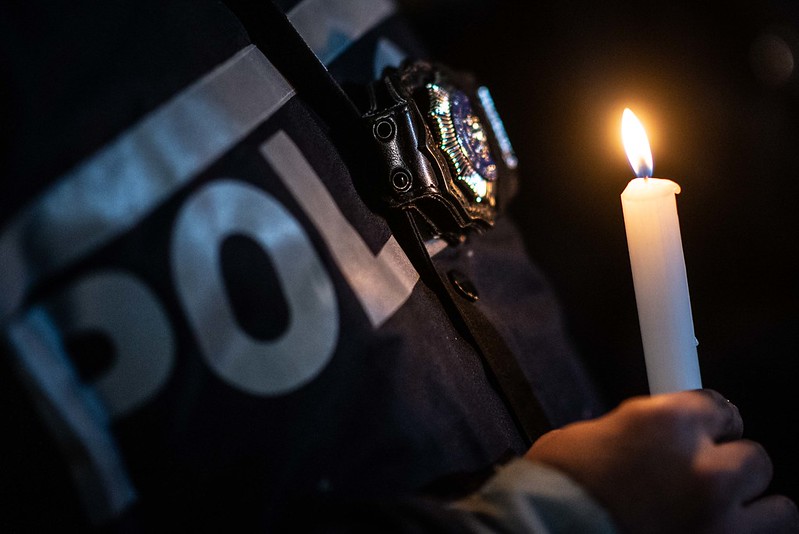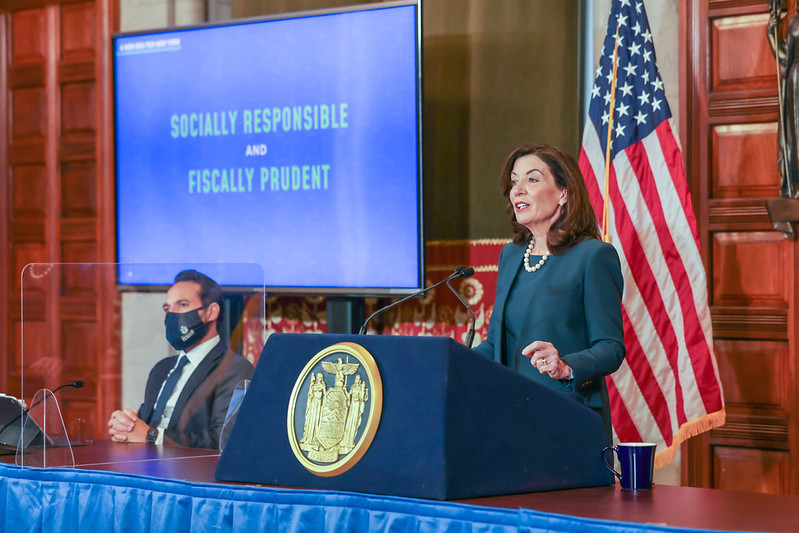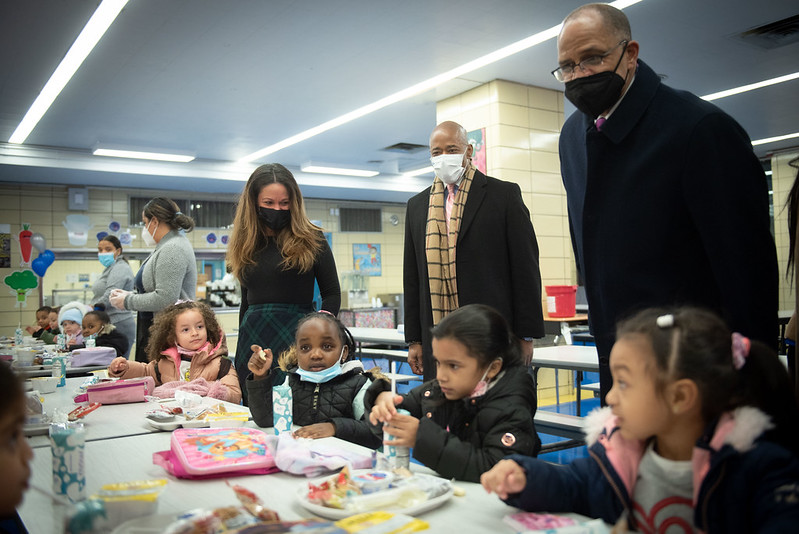A Key Lesson of the Harlem Police Shooting

A vigil for police officers Rivera and Mora (photo: Michael Appleton/Mayor's Office)
Mayor Adams' Blueprint to End Gun Violence, just released with much fanfare, represents, regrettably, an old-wine-in-a-new-bottle agenda overly-reliant on punitive law enforcement tactics. The mayor seeks to roll back bail reform and criminalize more young people, and will return to our streets the notorious plainclothes NYPD units responsible for the deaths of Eric Garner, Sean Bell, and others. These measures would do nothing to prevent the shocking kind of tragic incident that took the lives of police officers Jason Rivera and Wilbert Mora.
The main impact of such policies will be an increase in both the arrests of young Black and Latino men and the number of New Yorkers locked up in the hellish, inhumane conditions of Rikers Island, all of it unnecessarily disrupting thousands upon thousands of lives, including the families of those arrested and jailed. As Brooklyn Assemblymember Phara Souffrant Forrest posted on Twitter, specifically in regard to Adams' proposal to harden bail policy: "Locking up people because they are poor does not keep our neighborhoods safe."
The practice that the shooting of Officers Rivera and Mora should lead our city's leaders to most seriously reconsider is the daily routine of sending police officers to handle domestic disputes. How does it make sense to send a uniformed officer armed with a gun and taser to help resolve an argument between a mother and her grown son, as was the case in the fatal Harlem incident? Add to the import of this question: that the officers so assigned can be as young and inexperienced as 22 years old, as Rivera was, and that, for better or worse, but understandably, many New Yorkers of color loathe and/or deeply distrust police officers.
Why not dispatch social workers and family counselors instead of police officers, a move that immediately helps lessen the possibility of escalation? Though it does not appear to have been the case with Rivera and Mora, we know that too many police officers approach their jobs as an opportunity to use their might to control situations, often escalating them. Why not rely on professionals whose vocation is to relieve people in stress, to use their wits and compassion to de-escalate situations and offer help, rather than officers whose training often centers on how to use force?
It is likely that had New York City had such a practice in place that the outcome last Friday night would have been different. At the very least, do we think it probable that the shooter would have thrown open the door to his room and started firing a gun had he known that it was a couple of social workers walking down the hallway in his direction? Wouldn't it be likely that Officers Rivera and Mora would be alive today? Isn't it possible that trained professionals could have calmed Lashawn McNeil, the crazed gunman, and he, too, would still be alive?
A model for this type of alternate approach has functioned successfully in two Oregon cities, Eugene and Springfield, for decades. Crisis Assistance Helping Out on The Streets, aka CAHOOTS, has teams that consist mainly of EMTs and mental health professionals trained in conflict resolution who handle mental health emergencies and domestic disputes, among other matters. Started in the late 1980s, CAHOOTS has received more public funding over the years due to its effectiveness -- by 2017 it had expanded significantly so it now responds to over 20% of all emergency calls in Eugene.
Larger, more diverse cities in the U.S. have successfully adopted the CAHOOTS model. Austin's Mobile Crisis Outreach Team (MCOT) and Denver's Support Team Assisted Response (STAR) are two programs, for example, that have recently replicated the Oregon model. New York City policy-makers should follow suit and establish an emergency response system that replaces police officers with social workers and other trained healthcare professionals. Our great city needs an approach that results in saving lives.
***
Robert Gangi is the Director of the Police Reform Organizing Project, or PROP. On Twitter @GangiFromProp.
***
Have an op-ed idea or submission for Gotham Gazette? Email This email address is being protected from spambots. You need JavaScript enabled to view it.
For State's Future, The Governor Must Say No Sometimes

Gov. Hochul presents her budget (photo: Mike Groll/Office of Governor Kathy Hochul)
Now that Governor Hochul’s State of the State address and budget presentation have been delivered, the drumbeat of advocates, interest groups, legislators and other officials seeking increased spending will grow louder. With the primary election in only six months the temptation is strong to give everyone at least some of what they want. But, flush as the state’s coffers are right now, New York cannot afford to do it all and difficult decisions that make some important groups unhappy must be made.
The State financial plan update included in the Executive Budget shows that over the five-year period of fiscal years 2022-2027, State Operating Funds disbursements will increase by almost $26 billion, an average of 4.1% annually, higher than the growth rates prior to the pandemic. Once the substantial one-time federal funds that supplement state-generated revenue are exhausted, the State will have to fund all the programs already included in the budget on its own.
While Budget Director Robert Mujica asserts that this can be done with no deficits all the way through fiscal year 2027, he concedes that the optimistic projections for state revenue growth could change because of the continued impact of the pandemic or for other unforeseen reasons. And the generous spending included in the governor’s budget depends on the ‘temporary’ multi-year tax increases on high-earning residents and corporations adopted last year that, notwithstanding Mujica's recent assurance to the contrary, could be incentivizing wealthy businesses and individuals to leave the state.
It is noteworthy and wise that Governor Hochul proposes to set aside $5 billion in each of the next two fiscal years in reserves in case of a ‘rainy day.’ But it is difficult to believe that the Legislature will go along or that the Governor will be able to resist contentions from legislators, advocates, and others that the money is needed for a variety of worthy causes, even though she has already set aside $2 billion for covid-related needs to be allocated in consultation with the Legislature.
Some actions the governor has already taken are cause for concern. She announced that the state will fully implement the exorbitant and poorly-targeted increases in school aid required by the lawsuit filed by the Campaign for Fiscal Equity, giving all school districts increases even though over $2 billion a year is already provided to districts that have enough to fund a sound basic education for all their students. And she recently signed 16 bills passed by the Legislature that ‘sweeten’ pension benefits for public employees, the type of bills that were routinely vetoed by Governor Cuomo because of their long-term costs.
An example of the kind of well-intentioned but costly and unwise initiatives that should be avoided is the “New Deal for CUNY” campaign to make all the community and senior colleges in the CUNY system tuition free for all New York residents. A bill to implement this policy was introduced in both the Senate and Assembly and has the support of a number of members as well as student groups and the union representing CUNY faculty.
The amount of state support to CUNY (about $1.7 billion before the new additions) is two times the operating spending of the State Police and four times more than operating spending on parks and the environment. The governor’s budget adds approximately $350 million in additional operating subsidies to SUNY and CUNY as well as funding tuition assistance grants for part-time students.
Most resident CUNY students pay no tuition because of their eligibility for city, state, and federal grants. Tuition only covers about one quarter of CUNY’s costs; to eliminate this source of revenue would make the 23 campuses even more dependent on the state of New York’s economy and political calculations than is already the case. That is why legislation was enacted in 2020 to allow for regular, small increases in tuition. It should not be undone.
I am an ardent believer in the power of CUNY — I helped to launch CUNY ASAP, the most successful community college completion program in the country — and fear that eliminating its relatively small tuition payments will make its financial status more precarious.
Nor should the similar, smart practice of regular, small fare and toll increases to help the MTA keep up with inflation be discontinued. Adopted in 2009, the policy ameliorated the prior pattern of periodic significant fare and toll increases that were fiscally and politically wrenching. The 2020 increase was postponed due to the pandemic and, thanks to a $6 billion aid infusion from federal relief funds, the governor’s budget postpones the 2022 increase as well. Several types of discounts for multiple rides have also been instituted.
As ridership grows back towards pre-pandemic levels, the regular fare increases should be resumed. To maintain affordability for those with lower incomes, New York City should continue robust efforts to promote its Fair Fares program, which provides half-price transit service to lower-income residents. As with CUNY, our public transit system needs reasonable user fees to provide some level of fiscal stability.
There are a number of other steps that should be taken to put the state on a firm financial footing, such as shifting economic development efforts away from the billions spent on tax incentives and business subsidies, and rightsizing and better managing capital spending.
Saying no to seemingly attractive policies that increase state spending is going to be very tough when the state seems awash in money and there is an election imminent. It may be easy and expedient to provide as many ‘free’ services as possible now, but it will be extremely difficult to undo these policies down the road when trade-offs between these and other services for the neediest New Yorkers, like the growing Medicaid program, become necessary. For everyone’s sake and the future of New York, the governor needs to hold the line on building up reserves.
***
Carol Kellermann was president of Citizens Budget Commission from 2008 through 2018.
***
Have an op-ed idea or submission for Gotham Gazette? Email This email address is being protected from spambots. You need JavaScript enabled to view it.
4 Ways Mayor Adams and Chancellor Banks Can Support Our Most Vulnerable Students

Mayor Adams and Chancellor Banks at a school (photo: Michael Appleton/Mayor's Office)
In an interview late last year, New York City’s new schools chancellor, David Banks, vowed to “transform the lives of…[New York City] children, but particularly Black and brown children who have struggled the most in this system.” While all students have struggled during the pandemic, multilingual learners, students in the foster system and in temporary housing, and students with disabilities—who are disproportionately Black and brown—have faced additional challenges, as the pandemic has exacerbated enduring opportunity gaps and academic disparities.
At the same time, the city has more resources for education than ever before. For Chancellor Banks to deliver on his promise, he must focus on targeting and increasing resources for these special student populations.
Data available from the New York City Department of Education (DOE) make it clear that many special student populations fail to receive the support they need. Students in the foster system were approximately 3.5 times more likely to repeat a grade than all other DOE students, according to data from the 2015-2016 school year (the most recent available). In 2019, less than one in five multilingual learners were proficient in math. And January 2021 data reveal increased absenteeism during the pandemic for multilingual learners, students with disabilities, and students in shelter.
With increased funding, the new city administration, working with the City Council, has a historic opportunity to invest in ambitious and equitable programs that focus on the unique needs of students from special populations, and ensure students’ access to fully participate and thrive in them.
Throughout the pandemic so far and over the next several school years, the DOE will have received immense sums of federal covid-related education aid, including $7.3 billion for elementary and secondary education (on top of regular federal funding for education) and a significant portion of the nearly $59 million in federal aid awarded to New York State for students in temporary housing. State funding is also increasing, notably through the state’s commitment to finally fully fund Foundation Aid in the coming years. This school year, the DOE is receiving $11.8 billion from the state, including $8.6 billion in Foundation Aid. With these investments, the DOE’s 2021-2022 budget is $38 billion, which includes departmental allocations toward expanding early literacy, special education, 3-K, culturally-responsive curriculum, and other priority programs.
However, some of the DOE’s programs that were funded by covid-relief dollars—such as Summer Rising—were difficult to access for many vulnerable populations, exacerbating the challenges for students who had already faced more barriers to school early in the pandemic. Some advocates attributed access challenges to limited busing options, outreach failures, and communication gaps.
One immigrant parent of two multilingual children told us that she feels like her children are excluded from new DOE programs because of language barriers. “My daughter’s school always sends me those robocalls in English and never uses a translator except for IEP meetings. They send me papers in the mail, but they are in English. I have to talk to somebody to figure out what they’re saying,” she said in Spanish. “More than anything, I want [my children] to achieve their goals.”
Children like hers, and so many others across the city, deserve better. Chancellor Banks can deliver on his commitment to transform the lives of Black and brown children by taking the following steps:
1. Utilize existing outreach structures—and create new ones—to reach special student populations and their families.
The DOE should mobilize existing staff (parent coordinators, social workers, recently-announced central foster care staff, and others) to ensure that students and their families have access to new programs. Additionally, the DOE should develop new outreach strategies with input from parents, students, and other key stakeholders who are members of historically-underserved communities, including partnering with community-based organizations that have trusting relationships with these families.
2. Create targeted academic programs and provide necessary services to enable full participation.
Students in special populations need targeted academic support provided by appropriately-trained staff to address ongoing challenges and ensure unencumbered access to programs (whether they are offered after school, in school, or on weekends), including transportation, paraprofessionals, and quality translation and interpretation services.
3. Collect and share participation data for new programs targeting special student populations.
The DOE should gather and publish this data for individual special student population groups and disaggregate by race, ethnicity, gender, and geographic district to better understand who has access to city programs and address gaps.
4. Develop trauma-informed programming that targets the whole student.
Supports must help students in special populations process their emotions and help them to persist through their education. School staff must be trained to understand the effects of trauma and adverse childhood experiences, how they manifest in the classroom, and how they can encourage positive social-emotional interactions.
The pandemic has highlighted systemic challenges within our schools that impact all students––especially the most underserved. Students in special populations need targeted supports and transformative change. Mayor Adams and Chancellor Banks have a historic opportunity and unprecedented funding—including Governor Hochul’s proposed future increases in state aid—to ensure these students have the opportunities they need to succeed. They must make good on their promise.
***
Alejandra Vázquez Baur and Chantal Hinds are Policy Entrepreneurs at the Next100 think tank, where they work on issues related to educational equity, students involved in the foster system, and immigration justice. On Twitter @TheNext100.
***
Have an op-ed idea or submission for Gotham Gazette? Email This email address is being protected from spambots. You need JavaScript enabled to view it.




